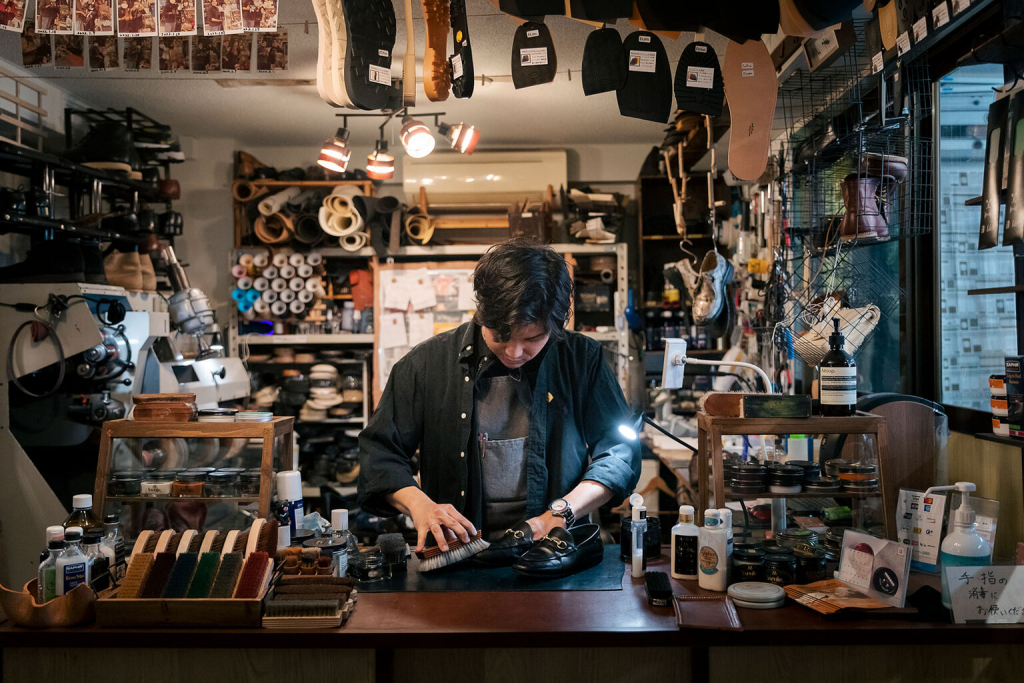Tucked away in the charming Tomigaya neighborhood of Tokyo’s Shibuya district, Kumada Kutsuten is a stylish little enclave dedicated to shoe shining and repair. Behind the counter is the friendly and welcoming face of Keiichiro Kumada, who, at just 28, is running all the services – shoe shining, shoe and bag repair – by himself. Upon entering, two friendly Boston terriers, Tono and Nene, the latter just a puppy, excitedly greet visitors. Strings of Polaroids featuring clients and their polished shoes hang from the ceiling, and a faint smell of leather fills the space. A few bear-themed decorations, a play on Kumada’s family name, adorn the shop.
The path to get where he is now isn’t exactly straightforward. Kumada studied to become a schoolteacher and he taught first grade at an elementary school for five years. “Being an elementary school teacher was really fun, and I still love children,” he says. But his true passion was always at the back of his mind. During his time at university, one of his hobbies was to shine shoes.
“I was impressed when dirty shoes became beautiful, and I realized that one day I wanted to become a shoeshine craftsman. Originally, I played baseball and enjoyed polishing gloves and cleats. From there, I became interested in leather, and I came to love leather shoes, which led me to become fascinated with shoe polish,” he says.
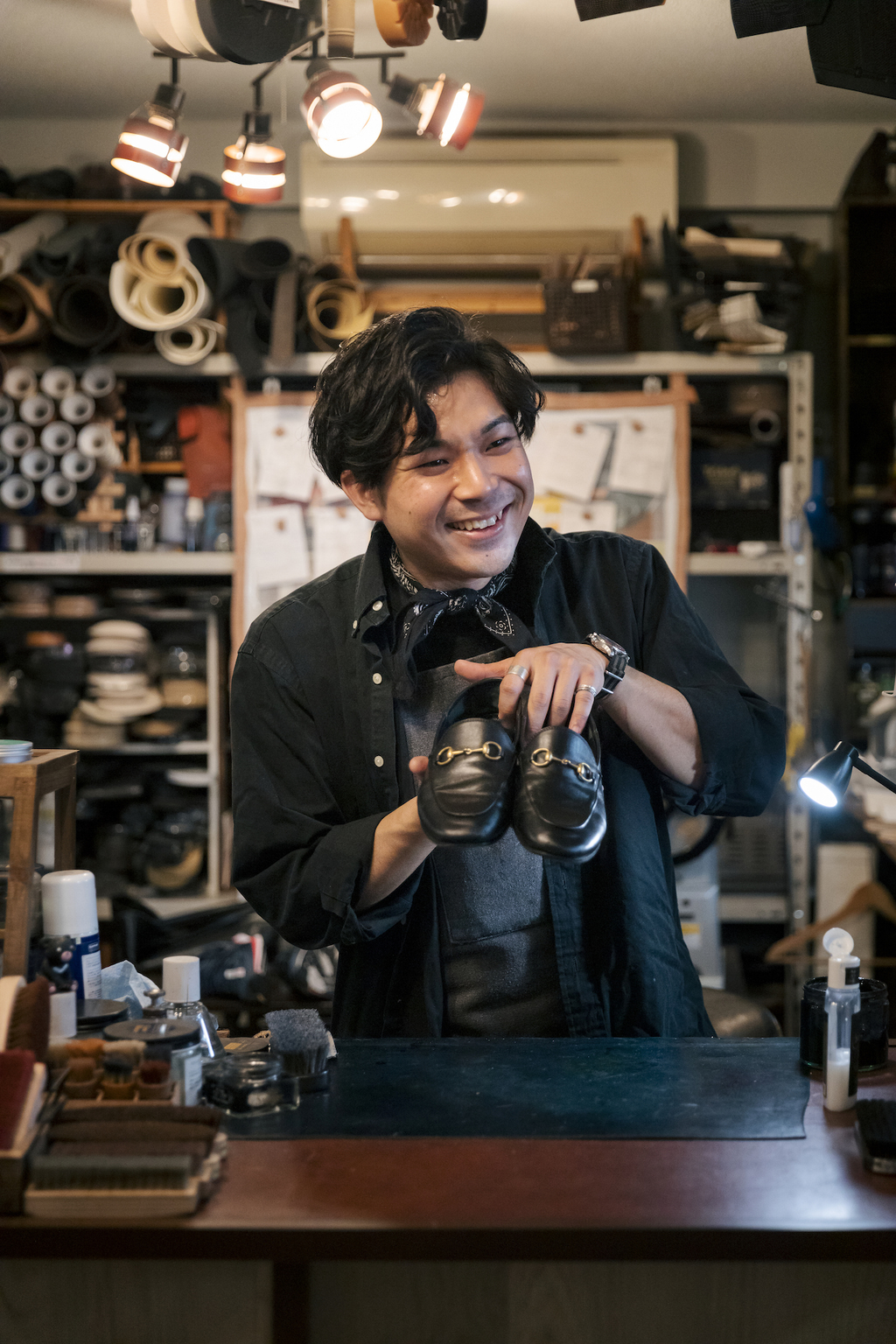
Like his fellow shoe shiners, Kumada learned the trade and honed his skills by practicing (there is no formal training). “I am completely self-taught. I researched things I didn’t understand on the internet, tried them myself, incorporated what worked for me, and studied books,” he adds.
Shoeshine artisanship is having a bit of a moment in recent years, especially amongst younger people, as the interest in menswear tailoring and footwear is increasing. A quick search for shoeshine on YouTube reveals not only a high number of skilled demonstrations and tips, but also ASMR videos, providing a soothing sound of brushes against leather. Various shoe shining competitions are organized annually around the world, including the World Championship in Shoe Shining and Shoe Patina in London. The Armoury, a chain of men’s bespoke clothing and accessories stores in New York and Hong Kong, even offers a shoe shine tutorial on its YouTube channel from the 2017 world champion, Yuya Hasegawa.
In August 2021, Kumada opened his shop in Tomigaya, just a few steps away from Yoyogi-koen Station, in a rented space that used to be a vintage clothing shop. “Tokyo is such a big city, but Tomigaya is different; it feels like a small community. It’s an area that values people,” he says. “The atmosphere has the perfect balance between modern and old-fashioned.”
Kumada adds that he loves walking the path from his shop to the train station, where shop owners all greet him. And every morning, he buys his coffee just across the street at Camelback (and in return the café owner takes his shoes over to Kumada’s shop).
When customers bring in their footwear, Kumada starts by carefully checking the structure of the shoe, the type of leather and the condition. “We change the way we finish it according to the environment that customers wear shoes in,” he explains.
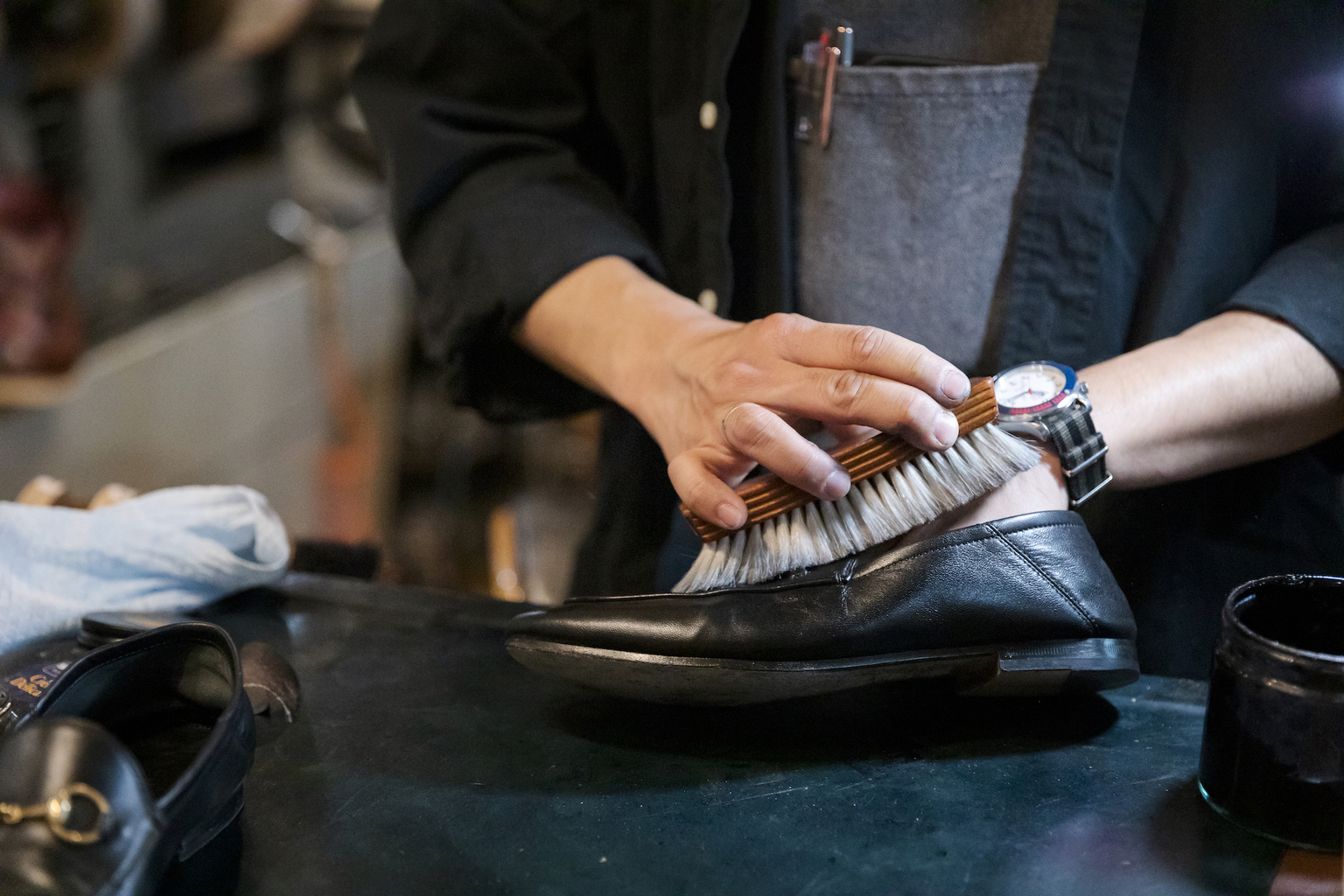
How often should someone take care of their shoes? Kumada says it depends on their lifestyle. “For example, an employee who walks and works every day as opposed to a person traveling by car – this will change the way the insoles are damaged.” For this reason, he likes to discuss with customers to find the appropriate finish for the shoe soles and for polishing to meet their needs.
I, for one, am guilty of not taking such good care of my shoes. The day I visited Kumada’s shop I was wearing black Gucci leather loafers – an extravagant purchase that really deserves to be treated better. As I tend to walk a lot around Tokyo, the toe area was clearly damaged and I secretly hoped Kumada wouldn’t notice my worn out shoes.
But the inevitable happened – he asked me to hand him my shoes so he could demonstrate his process, and I sheepishly acquiesced. First, he wiped my shoes with a towel, then used sandpaper on the damaged toe area to make it even. He then chose a black-tinted shoe cream and started expertly applying it to the shoe’s leather with his fingers, in quick back and forth movements. To me, that was probably the most surprising part, as I thought he would use more tools. “The heat from my fingers helps the cream melt into the leather,” he explained. After that, he applied a shining product with a brush (he has three types of brushes, in multiple counterparts as only one brush is used per color: pig bristle is the firmest, horsehair is medium and goat hair is the softest). The entire process took about five minutes and my shoes looked brand new.
His speed and precision were captivating. This standard course, which involves a cleaner to remove stains, a nourishing cream to protect the leather and a glossy finish comes in at only ¥1,650 – a small price to pay, I thought, to make shoes last longer (and look immaculate). According to him, my shoes should undergo full professional care once a year and be touched up with cream weekly (something that can be done at home with the right product).
For customers who want something a little more in-depth, he offers a luxury high-shine course with glaçage (the French word for icing) shoe polish, where he mixes the wax with water for a mirror-like finish (¥2,750). He also offers care for suede, and for sneakers, to clean them and remove stains.
“All the polishing is done by hand,” says Kumada. “When polishing shoes, the amount of cream, for example, is adjusted with precision while checking the condition of the leather with my hands. But for shoe repair, the soles are scraped using a machine.”
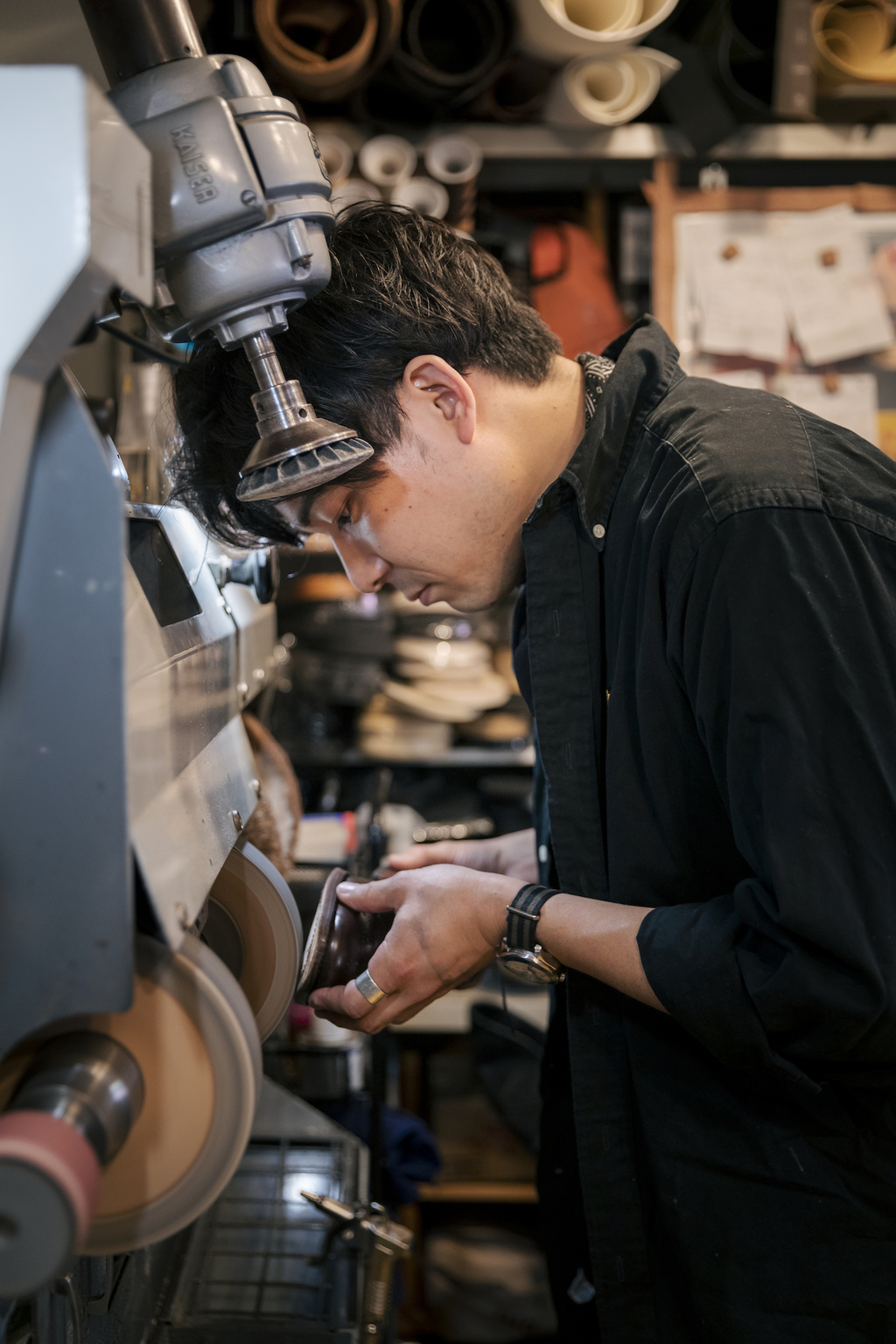
He shows a large machine he uses for sanding soles, a model made in the Netherlands in 2000 that he purchased secondhand. But everything else for shoe repair is done by hand. For example, Kumada uses a flat knife to level the soles.
“Not many people do it, but it’s an important detail. When you look at it from the side, you can see it’s perfectly leveled. It gives it a beautiful style,” he says. He also sharpens his own knives.
The walls surrounding him are covered with threads and leathers in different hues sourced from wholesale markets in Asakusa, as well as scissors, pliers, screwdrivers and various types of hammers.
“I actually don’t have that many tools yet, but I will accumulate them over the years,” he adds. Other equipment includes an oven-like device for drying sole glue and a vintage sewing machine from the 1960s.
A display shelf near the entrance is filled with seemingly brand new shoes – they’re actually old shoes that Kumada has completely revamped. Sustainability is a priority for him, and he started this project to give a new life to shoes that would otherwise go to waste.
“I repair shoes before they are thrown away, to turn them into shoes that can be worn again, so that people will wear them for a longer period of time,” he says.
Over the course of the last year, things have really exploded for Kumada. He had the opportunity to become a brand ambassador for Saphir, the prestigious French shoe leather care products maker that traces its origin back to 1920, and is highly regarded today by shoe aficionados. He had to undergo a technical test in order to become one of Japan’s 12 ambassadors. He also sells the brand’s products in his shop.
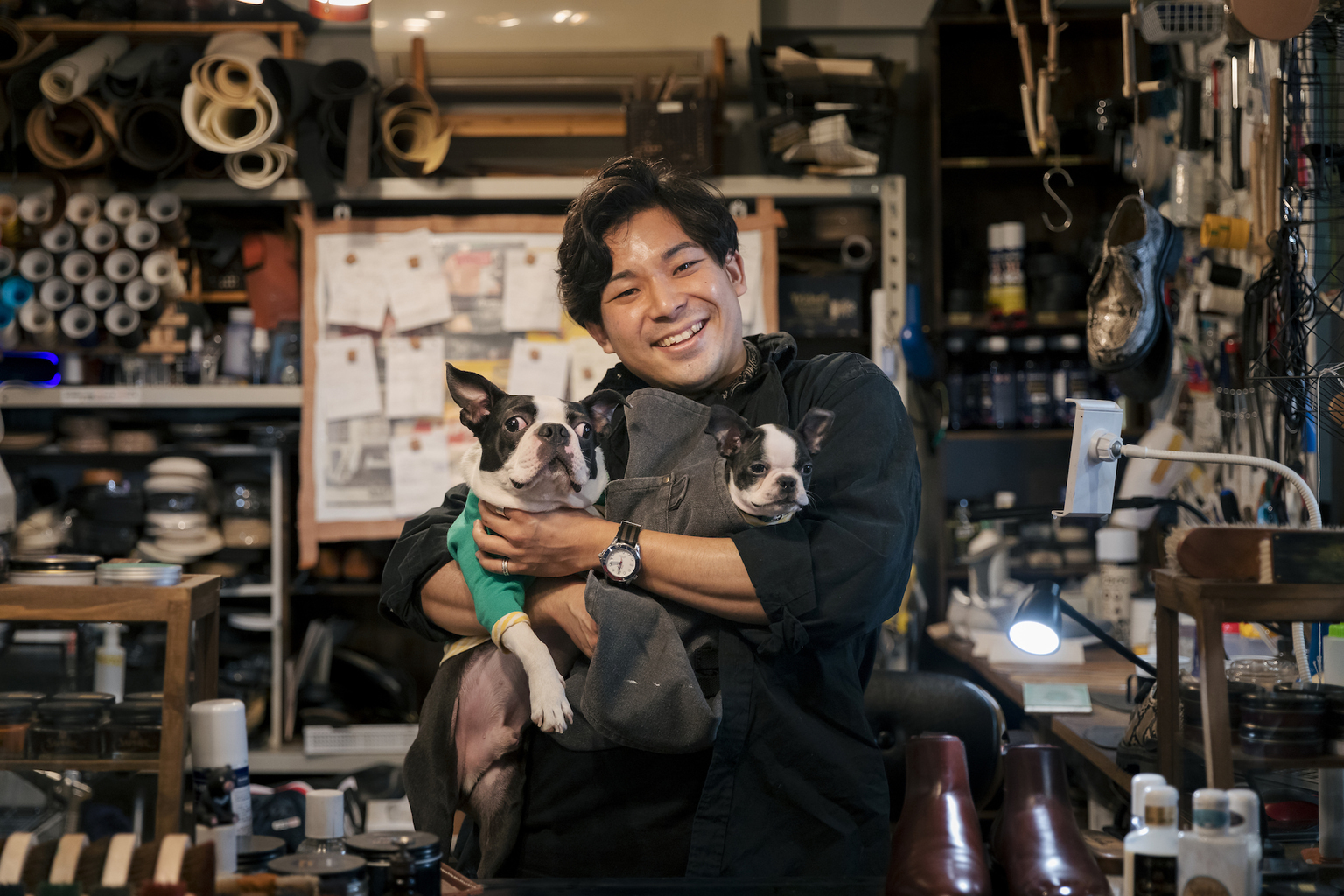
Shoe shining may typically be associated with men, but Kumada also wants to make his shop an inviting space for women. “I respect women customers and I want them to feel comfortable coming into this shop,” he says. He also hopes more women will train to become shoeshiners as there are currently very few in Japan. With the increasing number of customers, he is now looking for a part-time worker to help him out – hopefully a woman. The shop is open every day, except Monday. On his day off, Kumada enjoys going to dog cafés around Tokyo with his two pooches.
To him, nothing quite beats the satisfaction he gets from shining and repairing shoes. “It makes me feel happier to see shoes in good condition, and to see customers go home with a smile.”
Learn more about Kumada Kutsuten.
Photos by Anna Petek

